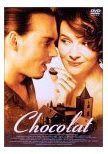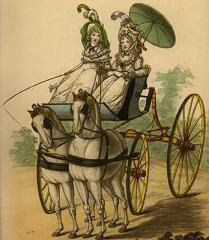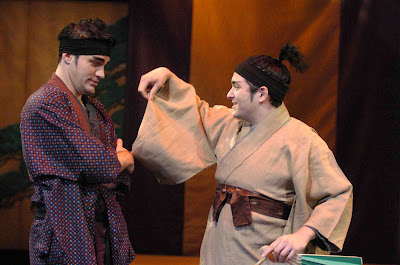 Yesterday, Keira suggested I tell you all how fared the production of Shakespeare’s The Winter’s Tale that Todd and I were in, which closed on Saturday.
Yesterday, Keira suggested I tell you all how fared the production of Shakespeare’s The Winter’s Tale that Todd and I were in, which closed on Saturday.
She also suggested I share some pictures. (All photo credits, by the way, go to Bob Paz, Caltech’s photographic genius.)
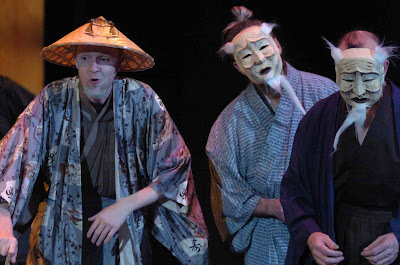 Ahem. Well. Let me start by saying that this was a visually stylized (and sometimes dramatically stylized) version set in feudal Japan. We had very odd hair and make-up, and lovely costumes which, however, did not flatter any woman who had a figure.
Ahem. Well. Let me start by saying that this was a visually stylized (and sometimes dramatically stylized) version set in feudal Japan. We had very odd hair and make-up, and lovely costumes which, however, did not flatter any woman who had a figure.
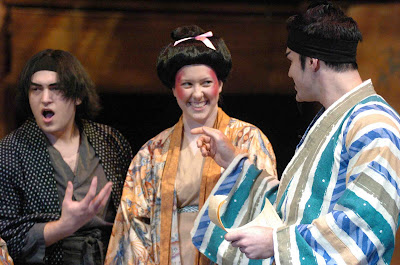 Did I say odd hair? For some of us, that meant odd wigs. Very odd wigs. And the women’s makeup consisted of nothing but a thin layer of very pale base, and a large amount of very pink rouge bracketing the eyes. This lady here (not me) is an example of both wig and makeup!
Did I say odd hair? For some of us, that meant odd wigs. Very odd wigs. And the women’s makeup consisted of nothing but a thin layer of very pale base, and a large amount of very pink rouge bracketing the eyes. This lady here (not me) is an example of both wig and makeup!
There — now that I have prepared you — you are prepared, are you not? You won’t laugh (too much)? Very well.
 Here’s Todd as King Leontes, going mad. (He did a lot of that in this play.) This is when King Leontes becomes suddenly (and wrongly) convinced that his wife, Queen Hermione, has been cheating on him with his best friend — and that the child she’s pregnant with is a result of this (nonexistent) affair.
Here’s Todd as King Leontes, going mad. (He did a lot of that in this play.) This is when King Leontes becomes suddenly (and wrongly) convinced that his wife, Queen Hermione, has been cheating on him with his best friend — and that the child she’s pregnant with is a result of this (nonexistent) affair.
And, yes. Todd is wearing a wig. A huge wig.
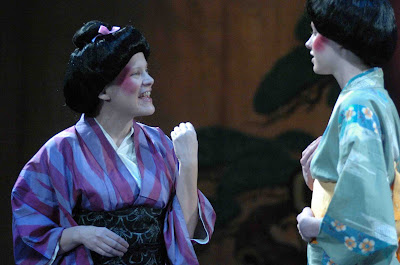 Now here’s me, in purple. And let me just say that I know the wig, the makeup, and the fifteen-foot-long obi wrapped around and around my waist, aren’t flattering to me. I know it. And I was remarkable in my restraint during this play in how little I stressed about it. (Honest! Well, maybe.) But I’m just saying.
Now here’s me, in purple. And let me just say that I know the wig, the makeup, and the fifteen-foot-long obi wrapped around and around my waist, aren’t flattering to me. I know it. And I was remarkable in my restraint during this play in how little I stressed about it. (Honest! Well, maybe.) But I’m just saying.
(I’m just saying, it’s all Keira’s fault. She made me show you these pictures.)
Okay. Sorry. Where was I? Oh yeah. In the above picture, my character, the lady Paulina, comes up with a brilliant plan. I will show Queen Hermione’s now newly born baby to mad King Leontes — who will of course melt at the sight of the cute little baby, and snap out of his madness.
 And here I am again as Paulina, with the baby, and with Antigonus, Paulina’s husband. Paulina breaks in on the king and insists he listen to her yell at him a lot (he yells too, of course — very Shakespearean), and insists he look at the cute little baby. In this picture, Paulina’s husband (who I suspect knows the king a bit better than she) is trying to get his wife and the baby out of the room before the king decides to execute them all.
And here I am again as Paulina, with the baby, and with Antigonus, Paulina’s husband. Paulina breaks in on the king and insists he listen to her yell at him a lot (he yells too, of course — very Shakespearean), and insists he look at the cute little baby. In this picture, Paulina’s husband (who I suspect knows the king a bit better than she) is trying to get his wife and the baby out of the room before the king decides to execute them all.
But does the king listen? Of course not! (I suspect Shakespeare thought that if men listened to women more often, the world would be a better place.) The king orders the baby be abandoned in the middle of the forest by poor Antigonus (the guy in green above). Then comes the most famous stage direction in all of Shakespeare: “Exit, pursued by a bear.” The bear, of course, makes poor Paulina a widow.
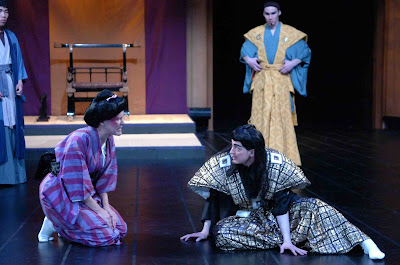 Meanwhile, the king defies the Oracle’s proclamation of Hermione’s innocence. So as the good always suffer for the sins of the wicked, King Leontes is punished by the gods by having his older child and heir, Prince Mamillius, die for his sins. (Not that the prince ever did anything bad!) In shock, Queen Hermione falls down dead of grief. In the above picture, Paulina is telling Leontes just how really really bad he is. This time, he believes her, and is really really sorry.
Meanwhile, the king defies the Oracle’s proclamation of Hermione’s innocence. So as the good always suffer for the sins of the wicked, King Leontes is punished by the gods by having his older child and heir, Prince Mamillius, die for his sins. (Not that the prince ever did anything bad!) In shock, Queen Hermione falls down dead of grief. In the above picture, Paulina is telling Leontes just how really really bad he is. This time, he believes her, and is really really sorry.
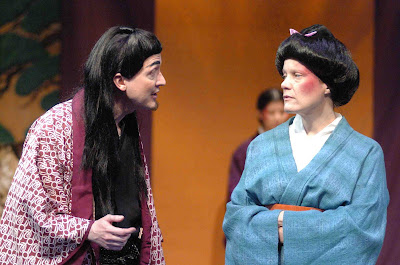 Sixteen years go by, and Leontes is still sorry, and Paulina is still making sure he stays that way. (You see how stern I look!)
Sixteen years go by, and Leontes is still sorry, and Paulina is still making sure he stays that way. (You see how stern I look!)
Meanwhile, the abandoned baby has grown up as a shepherdess, and a prince (son of Leontes’ old best friend) falls in love with her, and there’s lots of comedy and happy star-crossed love. (The first three pictures at the top are from this part of the play.)
 Eventually, everyone comes together, and they discover the shepherdess is really the daughter of King Leontes. Now everyone is mostly happy — so Paulina decides to show them the statue she has of dead Queen Hermione. And — surprise, surprise! It comes to life.
Eventually, everyone comes together, and they discover the shepherdess is really the daughter of King Leontes. Now everyone is mostly happy — so Paulina decides to show them the statue she has of dead Queen Hermione. And — surprise, surprise! It comes to life.
Guess Queen Hermione wasn’t really dead after all. Or…was she?
 Here’s Paulina, stealing center stage, more or less saying “can I help it if I can work miracles?”
Here’s Paulina, stealing center stage, more or less saying “can I help it if I can work miracles?”
Well, there you have it! Lots of pretty pictures. Lots of weird wigs. Lots of Cara pretending not to whine.
So — which costume (or hair) do you like best here? Or hate the least?
What’s the weirdest setting you’ve seen for a Shakespearean production?
When Shakespeare plays or movies are set in different times or places (e.g. McKellen’s Nazi-ish Richard III) do you love it, hate it, or think it all depends?
Cara
Cara King, author of My Lady Gamester and obsessive Shakespeare fan
 Whatever you can do or dream you can, begin it. Boldness has genius, magic power in it. Begin it now. – Goethe
Whatever you can do or dream you can, begin it. Boldness has genius, magic power in it. Begin it now. – Goethe


